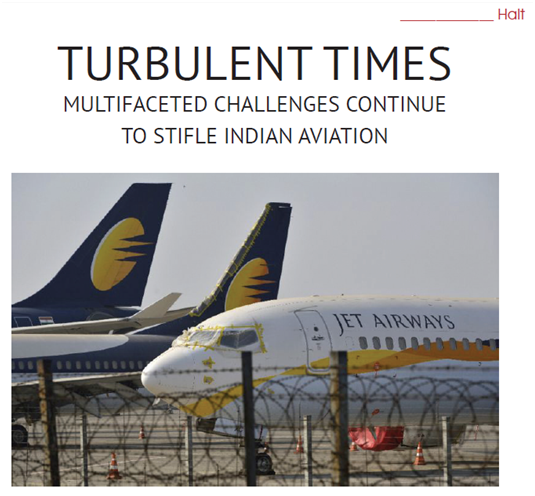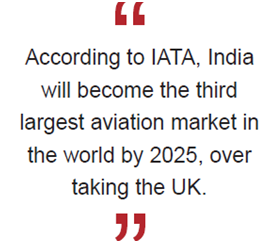
The Indian aviation industry took a massive blow on 17 April 2019 when Jet Airways was forced to indefinitely halt all its flight operations after its banks rejected its plea for emergency funds. Once known as the nation’s largest airline, it contained a fleet of around 120 largely Boeing Co planes.
According to the International Air Transport Association (IATA), India’s aviation sector supports 7.5 million jobs directly and indirectly in the country and makes up 30 billion rupees of its gross domestic product or 1.5 per cent of the economy. Data gathered from Directorate General of Civil Aviation (DGCA) reveals that India’s air passenger traffic has grown by at least 16% annually over the past decade. Domestic passenger traffic grew around 18.28 per cent to reach 243 million in 2018-19 and is expected to become 293 million in 2020. When it comes to international passengers, it grew by 10.43 per cent to reach 65 million in 2018 and traffic is expected to become 76 million in 2020. In 2018-19, domestic freight traffic stood at 1,213.06 million tonnes, while international freight traffic was at 2,143.97 million tonnes. India’s domestic and international aircraft movements grew 14.40 per cent and 9.40 per cent to 1,886.63 thousand and 437.93 thousand during 2017-18.
Despite the growth in market size, the last few years have turned out to be incredibly challenging for the aviation industry in India. One of the first factors resulting in huge losses has been the depreciation of the rupee. About 25-30% of costs incurred by airlines, excluding fuel, are dollar denominated—from aircraft lease rents and maintenance costs to ground handling and parking charges abroad.
Soaring prices of Aviation Turbine Fuel (ATF) is another humongous cost added to the airlines’ expenses. The ATF prices have risen from Rs 51,640 per kilolitre (KL) in September to Rs 63,162 per KL in March 2018, a rise of 22.31 per cent in about six months. Overall, the average ATF prices during 2017/18 were higher by 10.4 per cent year-on-year. The Centre charges 14% excise duty on ATF. The states add their own sales tax that can go as high as 29%. The surge in ATF prices is negatively impacting the financial performance of the airlines due to their inability to pass on the increased fuel cost to the customers. High ATF prices drastically increase the operation costs of airlines. Although the government of India calls for an increase in foreign direct investment of airlines in Indian carriers, the huge operation costs deter many.
the airlines’ expenses. The ATF prices have risen from Rs 51,640 per kilolitre (KL) in September to Rs 63,162 per KL in March 2018, a rise of 22.31 per cent in about six months. Overall, the average ATF prices during 2017/18 were higher by 10.4 per cent year-on-year. The Centre charges 14% excise duty on ATF. The states add their own sales tax that can go as high as 29%. The surge in ATF prices is negatively impacting the financial performance of the airlines due to their inability to pass on the increased fuel cost to the customers. High ATF prices drastically increase the operation costs of airlines. Although the government of India calls for an increase in foreign direct investment of airlines in Indian carriers, the huge operation costs deter many.
The Airport Authority of India (AAI) levies exorbitant charges on airports designated as international airports. This results in domestic carriers incurring additional charges without availing any added facilities. The airport charges levied by the Indian airports in both domestic and international terminals are amongst the highest in the Asian and the Gulf countries. This creates added financial burden on the airlines.
Intense competition among the existing carriers to capture market share is creating adverse effects for the industry as a whole. With the growing number of airlines, there is rising competition, and as companies add more flights, it has become increasingly difficult to be profitable. High ATF prices and heightened levels of competition have taken a toll on the yields of the airlines. Yield, in simple terms, denotes the money that an airline makes from a paid passenger on each kilometer of travel.
Even with crippling challenges, there seems to be a silver lining for the aviation industry. According to aviation industry firm Capa India, airlines in India are expected to lower their annual losses as a result of a fall in jet fuel prices and higher fares. At the Capa India annual summit in New Delhi, Capa’s Chief Executive Officer (CEO) and Director South Asia Kapil Kaul said that budget as well as full-services carriers are expected to lose between $550 million and $700 million in FY20, compared with a combined loss of up to $1.7 billion this year through March. The latest forecast is likely to cheer airlines as well as investors in India’s aviation industry where most of the carriers are struggling financially and saddled with large debt. Domestic traffic will grow 14%-16% annually from FY20 according to Capa India estimates. At the same time, international traffic is expected to grow 10-12% as local carriers add more than 90 planes to their fleet. According to 0, India will become the third largest aviation market in the world by 2025, over taking the UK.
The government of India has undertaken several initiatives to boost the aviation industry.
Sampurnaa Dutta
To read the further articles please get your copy of Eastern Panorama May issue @http://www.magzter.com/IN/Hill-Publications/Eastern-Panorama/News/ or mail to contact @easternpanorama.in


